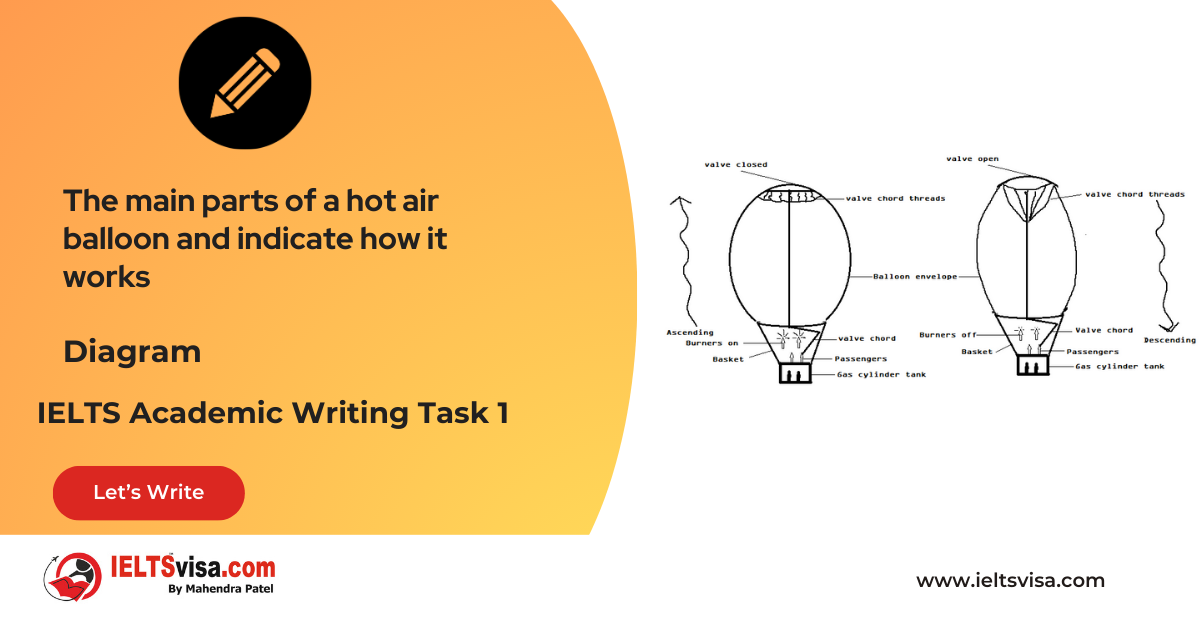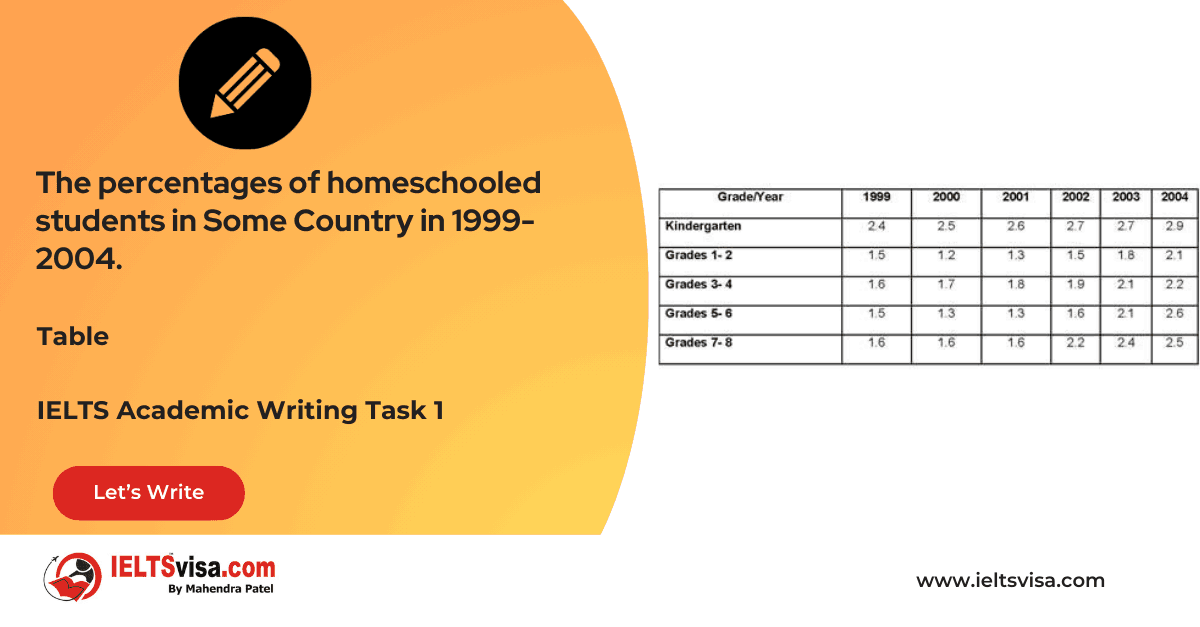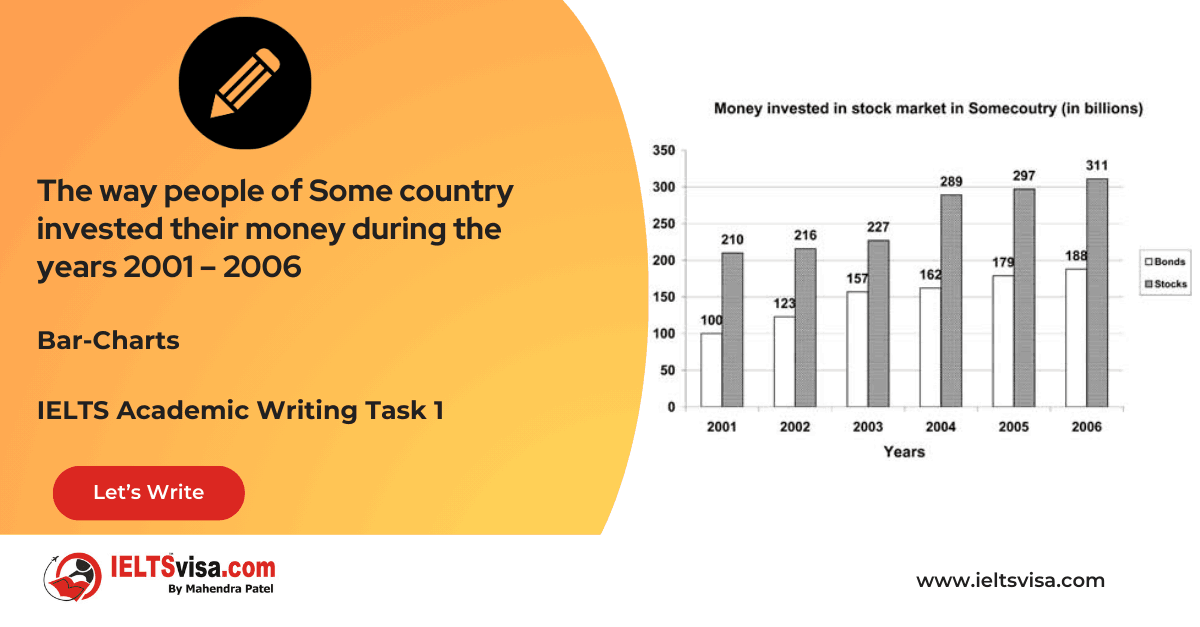The production of cacao beans in six regions between 1992 and 1998
IELTS Academic Writing Task 1 - Tables
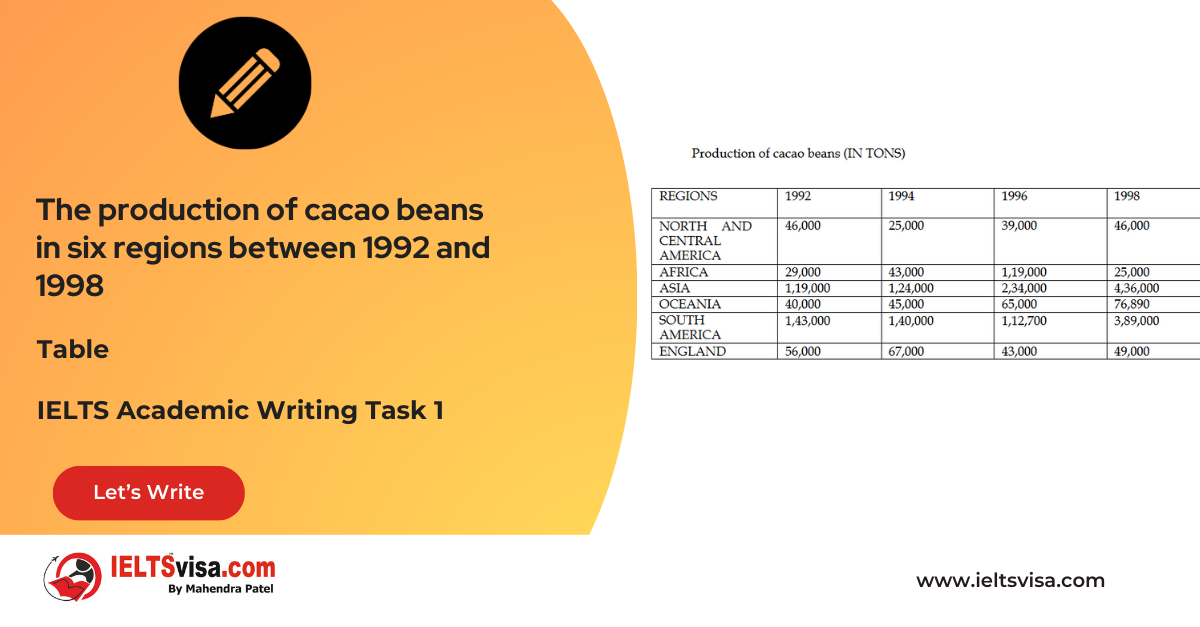
IELTS Writing Task 1 Question
The table below shows the production of cacao beans in six regions between 1992 and 1998. Summarise the information by selecting and reporting the main features and make comparisons where relevant.
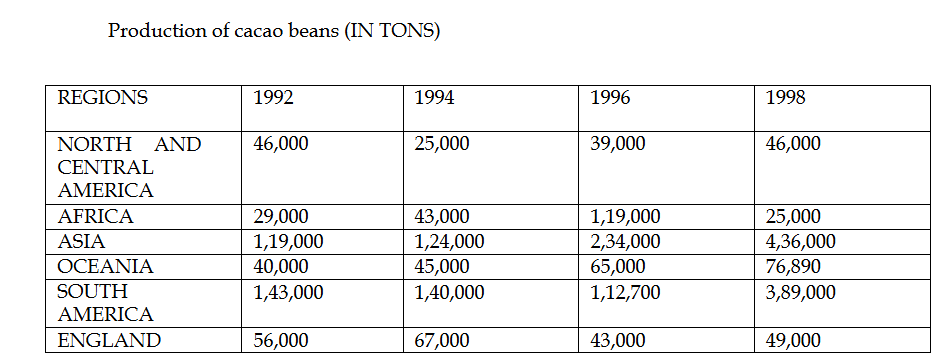
Common Questions for the Table
1. Graph Type: Table
2. Title: Cacao Bean Production in Six Regions (1992-1998)
3. What are the units of measurement?: Tons
4. Who: Regions producing cacao beans
5. When: Years 1992, 1994, 1996, and 1998
6. Where: Six regions (South America, Asia, Oceania, Africa, England)
7. Topic: Cacao bean production statistics
Comparison Showing and Trends Any change over time (such as an increase or a decrease) is a trend.
Comparison 1 : Highest and Lowest Producers
- Details:
- South America had the highest cacao production in 1992 with 143,000 tons, though it experienced slight declines in 1994 and 1996 before rebounding to 389,000 tons in 1998.
- Asia surpassed all regions by 1998 with a production of 436,000 tons, showing significant growth from 119,000 tons in 1992.
Comparison 2 : Fluctuations and Trends in Other Regions
- Details:
- Oceania showed steady growth, nearly doubling production from 40,000 tons in 1992 to 76,890 tons in 1998.
- Africa had a fluctuating pattern, with production nearly tripling from 29,000 tons in 1992 to 119,000 tons in 1996, but then dropping drastically to just 25,000 tons in 1998.
- England’s production remained relatively stable, fluctuating between 43,000 and 67,000 tons throughout the period.
Sample Answer
The table presents the production figures for cacao beans in six regions between 1992 and 1998. It is evident that South America and Asia were the leading producers during this period.
In 1992, South America produced 143,000 tons of cacao, the highest among all regions, despite a slight decline in production in 1994 and 1996. By 1998, production rebounded to 389,000 tons. In contrast, Asia’s production increased significantly from 119,000 tons in 1992 to 436,000 tons by 1998, making it the top producer in that year.
Oceania also experienced growth, with production nearly doubling from 40,000 tons in 1992 to 76,890 tons in 1998. Africa exhibited a more erratic trend, with production rising sharply from 29,000 tons in 1992 to 119,000 tons in 1996, but plummeting to 25,000 tons in 1998. Meanwhile, cacao production in England remained relatively stable, ranging from 43,000 to 67,000 tons.
Overall, while cacao production increased in South America and Asia, other regions like Africa showed significant fluctuations.
Top 27 Vocabularies
| Vocabulary (type) | Meaning | Synonyms | Examples |
| Production (n.) | The process of creating or manufacturing goods | Output, yield | “The production of cacao was higher in South America.” |
| Region (n.) | A specified area or division | Area, territory | “Cacao production in six global areas was analyzed.” |
| Fluctuating (adj.) | Rising and falling irregularly | Unstable, varying | “Africa exhibited a fluctuating trend in cacao production.” |
| Cacao (n.) | A tropical tree from which cocoa is derived | Chocolate bean | “Cacao beans are crucial for chocolate production.” |
| Rebound (v.) | To recover or return to a previous state | Bounce back, recover | “Production rebounded to 389,000 tons by 1998.” |
|
Figures (n.) |
Numbers or statistics |
Data, statistics |
“The figures show a significant increase in output.” |
|
Decline (v.) |
To decrease or lessen |
Diminish, drop |
“The production declined in 1994 and 1996.” |
|
Rebounded (v.) |
To recover after a decline |
Bounced back, revived |
“By 1998, production rebounded to higher levels.” |
|
Significant (adj.) |
Important or noteworthy |
Major, considerable |
“Asia saw a significant increase in cacao production.” |
|
Increase (v.) |
To become larger or greater |
Rise, grow |
“Production increased significantly from 1992.” |
|
Sharp (adj.) |
Sudden and strong |
Sudden, dramatic |
“The sharp rise in Africa’s production was unexpected.” |
|
Erratic (adj.) |
Unpredictable or irregular |
Unstable, inconsistent |
“The trend was erratic, fluctuating greatly.” |
|
Plummeting (v.) |
To fall or drop steeply |
Descending, dropping |
“The production plummeted in 1998.” |
|
Remained (v.) |
To stay in the same state or condition |
Stayed, continued |
“Cacao production in England remained stable.” |
|
Range (v.) |
To vary or differ in extent |
Vary, fluctuate |
“Production ranged from 43,000 to 67,000 tons.” |
|
Leading (adj.) |
Being in the top position or rank |
Top, foremost |
“South America was the leading producer in 1992.” |
|
Amount (n.) |
A quantity or total |
Quantity, sum |
“The total amount of cacao produced in Asia was substantial.” |
|
Global (adj.) |
Relating to the whole world |
Worldwide, international |
“The table analyzes global cacao production.” |
|
Trend (n.) |
A general direction or pattern |
Pattern, movement |
“The trend in production fluctuated across regions.” |
|
Range (n.) |
The extent or scope of something |
Scope, spectrum |
“The range of production varied from 29,000 to 436,000 tons.” |
|
Territory (n.) |
A defined area or land |
Area, domain |
“The regions covered different territories.” |
|
Sharp (adj.) |
Strong or intense |
Steep, sudden |
“There was a sharp decline in Africa’s cacao production.” |
|
Recovery (n.) |
The process of returning to normal or better state |
Restoration, bounce back |
“The recovery of production in South America was evident.” |
|
Erratically (adv.) |
In an unpredictable or irregular manner |
Unpredictably, inconsistently |
“Africa’s production fluctuated erratically over the years.” |
|
Rebound (n.) |
A return to a better condition after a decline |
Recovery, resurgence |
“There was a rebound in South America’s cacao production by 1998.” |
|
Substantial (adj.) |
Considerable in amount or size |
Significant, considerable |
“Asia showed substantial growth in cacao production.” |
|
Declining (adj.) |
Diminishing or decreasing |
Decreasing, falling |
“The production was declining during certain years.” |

Our Books
Master IELTS Speaking Part 1
IELTS Writing Task 1 Book
IELTS Writing Task 2 Book
Writing Task 1 Question Types
Practice IELTS Other Modules
IELTS Listening
The IELTS Listening test assesses how well you can understand spoken English in various contexts. It lasts about 30 minutes and is divided into four sections with a total of 40 questions. The listening tasks become increasingly difficult as the test progresses.
IELTS Academic Reading
The IELTS Academic Reading section assesses your ability to understand and interpret a variety of texts in academic settings. It is designed to evaluate a range of reading skills, including skimming for gist, reading for main ideas, reading for detail, understanding inferences, and recognizing a writer's opinions and arguments.
IELTS Speaking
The IELTS Speaking test assesses your ability to communicate in English on everyday topics. It lasts 11-14 minutes and consists of three parts: introduction, cue card, and a discussion based on the cue card topic.
IELTS General Reading
IELTS General Reading tests your ability to understand and interpret various types of texts. Here are some key areas and types of content you can expect to encounter in the reading section, along with tips for effective preparation.
IELTS Academic Writing Task 1
In IELTS Academic Writing Task 1, you are presented with a visual representation of information, such as graphs, charts, tables, or diagrams, and you are required to summarize, compare, or explain the data in your own words.
IELTS General Writing Task 1
In IELTS General Writing Task 1, you are required to write a letter based on a given situation. The letter can be formal, semi-formal, or informal, depending on the prompt. Here’s a breakdown of the key components to include in your letter
IELTS Academic Writing Task 2
In IELTS Academic Writing Task 2, you are required to write an essay in response to a question or topic. Here’s a guide to help you understand the essential elements of this task
IELTS Exam Tips
To succeed in the IELTS exam, practice regularly, familiarize yourself with the test format, improve your vocabulary, develop time management skills, and take mock tests to build confidence.
Grammer for IELTS
Grammar is the foundation of effective communication in English. Understanding tense usage, subject-verb agreement, and sentence structure enhances clarity and coherence in writing and speaking.
Vocabulary for IELTS
Vocabulary plays a crucial role in the IELTS (International English Language Testing System) exam, especially in the Speaking and Writing sections. Here’s an overview of why vocabulary is important and how it impacts your performance
RECENT IELTS SAMPLES QUESTIONS AND ANSWERS
Task 1 – Diagram – A conference hall built in 1981 and planned for 2020
20:00 Start Pause Stop [df_adh_heading title_infix="IELTS Writing Task 1 Question" use_divider="on"...
Task 1 – Table – The percentages of homeschooled students in Some Country in 1999-2004.
20:00 Start Pause Stop [df_adh_heading title_infix="IELTS Writing Task 1 Question" use_divider="on"...
Task 1 – Table – For a university tutor describing the information shown.
20:00 Start Pause Stop [df_adh_heading title_infix="IELTS Writing Task 1 Question" use_divider="on"...
Task 1 – Bar-Charts – The way people of Some country invested their money during the years 2001 – 2006
20:00 Start Pause Stop [df_adh_heading title_infix="IELTS Writing Task 1 Question" use_divider="on"...
Task 1 – Diagram – Rainwater Harvesting and Conversion to Drinking Water in an Australian Town.
20:00 Start Pause Stop [df_adh_heading title_infix="IELTS Writing Task 1 Question" use_divider="on"...
Task 1 – Column graph – Percentage of Young People Enrolled in Universities in 2000 and 2007.
20:00 Start Pause Stop [df_adh_heading title_infix="IELTS Writing Task 1 Question" use_divider="on"...

